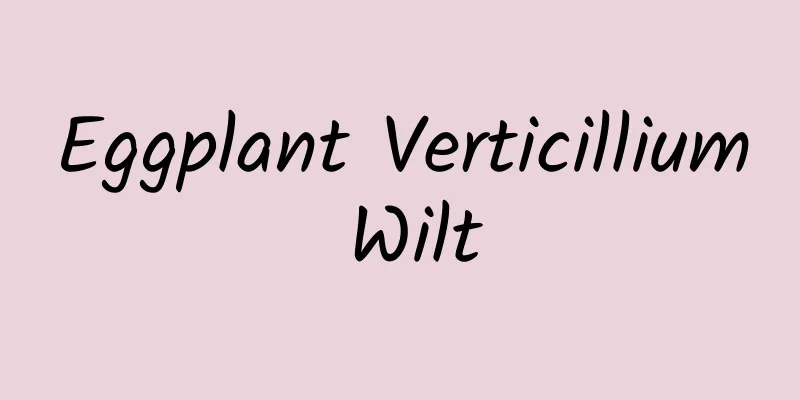Eggplant Verticillium Wilt

|
Today I will tell you about the pathogenic symptoms and prevention methods of eggplant wilt: pathogenThe pathogen of eggplant Verticillium wilt is Verticilli-um dahliae Kleb., a fungus of the subphylum Ascomycota. The conidiophores of the pathogen are erect and slender, with several layers of small stalks arranged in a whorl, and the top of the stalks bear oval, single-celled, colorless conidia. The thick-walled spores are brown and oval. Many black microsclerotia may be formed. Eggplant Verticillium Wilt symptomThe disease usually occurs after the eggplant has set fruit. The lower half of the leaves on the plant turn yellow near the petiole and between the veins. Gradually, half or the entire leaf turns yellow, and the leaf margin curls slightly upward. Sometimes the lesions are limited to half of the leaf, causing the leaf to be distorted. On sunny days with high temperatures, the diseased plants wilt, and recover at night or on rainy days. When the disease progresses rapidly, the entire leaf often turns yellow, brown and dies. The symptoms gradually develop from the bottom to the top. In severe cases, the entire plant leaves fall off. Most of the time, the entire plant is infected, and a few still have some healthy branches without disease. The diseased plants are short and the plant shape is not stretched. The fruits are small and the long fruits are sometimes bent. If the rhizome is cut longitudinally, the xylem vascular bundles can be seen to be discolored, yellow-brown or brown. Damage to cropsIn addition to eggplant, it also harms a variety of vegetables such as sweet (spicy) peppers, tomatoes, potatoes, melons, as well as a variety of crops such as cotton and sesame. Disease patternThe pathogen of eggplant Verticillium wilt overwinters in the soil or attached to seeds with mycelium, thick-walled spores and microsclerotia along with diseased residues, becoming the primary source of infection in the second year. The pathogen can survive in the soil for 6-8 years. The pathogen spreads the disease through wind, rain, running water, people, animals and farm tools, and diseased seeds can spread the disease over long distances. The pathogen in the soil invades from the young roots, reproduces in large numbers in the ducts, and spreads to the whole plant with body fluids. The pathogen produces toxins, destroys the metabolism of eggplant, and causes plant death. The suitable temperature for the development of the pathogen is 19-24°C, and it stops developing above 30°C. Mycelium and sclerotia are lethal at 60°C and 10 minutes. Generally, the temperature is low, and the wounds caused by the roots during planting are slow to heal, which is conducive to the invasion of the pathogen. From the planting of eggplant to the flowering period, there are many days with an average temperature of 18~°C, heavy rainfall, and heavy disease caused by watering with cool well water. The terrain is low-lying, uncomposted organic fertilizer is applied, base fertilizer is insufficient, planting is too early, soil covering is too deep, roots are damaged when seedlings are removed, planting is too sparse, soil is prone to cracking, and the disease is serious in continuously cropped plots. Prevention and treatment methodsThe effective way to prevent and control eggplant Verticillium wilt is to select disease-resistant varieties and combine cultivation measures with chemical control: 1. Choose disease-resistant varieties, such as Changqie No. 1, Heiyouliang, Changyelang, Gangshan Zaoqi, etc. 2. Choose disease-free seeds or treat seeds. Save seeds from disease-free plants, or soak seeds in 500 times 50% carbendazim solution for 1 to 2 hours and then sow directly. 3. Agricultural prevention and control. Implement crop rotation for 3 to 4 years; grow seedlings in disease-free soil; apply sufficient well-rotted organic base fertilizer, increase the application of phosphorus and potassium fertilizers; remove diseased plants in time when they are found; and completely remove diseased residues in the field after harvest and burn them. 4. Chemical control. In the seedling stage, use 30% metalaxyl 800 times solution of Haohan High-tech plus 96% copper sulfate 1000 times solution to irrigate the roots and then transplant with the medicine, or use 50% carbendazim medicated soil (1 kg of medicine plus 40-60 kg of fine dry soil per mu) for hole application during planting. According to the test, in the early stage of the disease, 600-800 times solution of oxadiazine-methyl (30% oxadiazine, 8% azoxystrobin) was used for root irrigation treatment. Each plant was irrigated with 100 ml of the liquid, irrigated once every 5-7 days, and irrigated 2-3 times in a row. The diseased plants can quickly resume growth and the yield increase effect is significant. 5. Grafting and root replacement. Using wild eggplant No. 2, Yunnan wild eggplant, Japanese red eggplant, Tolobam (Japanese rootstock), CRP (South Korean rootstock) as rootstock, cultivated eggplant as scion, and cleft grafting can achieve more than 95% prevention effect. When grafting, sterile soil must be used to cultivate the scion to prevent the scion from being infected, otherwise it will affect the prevention effect. 6. Manage water and fertilizer skillfully. In the early stage of eggplant growth in June in the north, the ground temperature is low. Choose sunny and warm weather for watering, and avoid cold weather when watering causes the ground temperature to drop below 15°C, which may cause an outbreak of Verticillium wilt. In the high temperature season from mid-July to mid-August, water frequently with small amounts of water to prevent the soil from drying out or cracking, reduce root damage, and control the disease. After the eggplants set fruit, apply plant growth regulators such as Guobao or special foliar fertilizers for Solanaceae 2-3 times, or apply 10-15 kg of nitrogen fertilizer per 667 square meters each time to make the plants strong and enhance disease resistance. |
<<: How to graft eggplant How to graft eggplant
>>: Symptoms and prevention methods of eggplant fruit blight
Recommend
What is Johnson Matthey like? Johnson Matthey reviews and website information
What is Johnson Matthey? Johnson Matthey is a Brit...
Salty porridge
I believe everyone is familiar with salty porridg...
What is Yahoo Malaysia like? Yahoo Malaysia reviews and website information
What is Yahoo! Malaysia? Yahoo! Malaysia is the br...
How to eat white sweet potatoes most nutritiously
White sweet potato is a kind of potato, also call...
The efficacy and function of sand mustard
Sand mustard is a variety of mustard. Compared wi...
What are the benefits of eating chestnuts? What are the effects and functions of eating chestnuts?
In the golden month of October, chestnuts are ava...
Cultivation methods and precautions of daffodils
Narcissus is a common green plant for beautifying...
What are the benefits of litchi wine?
There are many types of wine, and fruit wine is a...
What are the disadvantages of eating guava?
Many people like to eat guava, but eating too muc...
The efficacy and function of the achene fruit and the medicinal value of the achene fruit
The achene fruit is not common in China. Many peo...
Tremella and Cherry Porridge
I guess not many of you know about the recipe of ...
Nutritional value of cabbage
Cabbage is the cabbage we often eat. This vegetab...
What are the benefits of eating black glutinous rice porridge
Black glutinous rice, also known as purple rice, ...
Rock Sugar Yam Porridge
Introduction of Rock Sugar Yam Porridge Rock suga...
Carp porridge
Some friends must be familiar with some knowledge...









